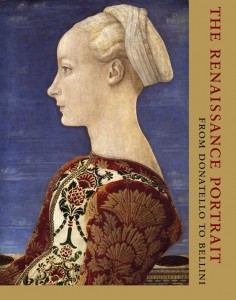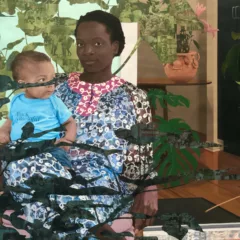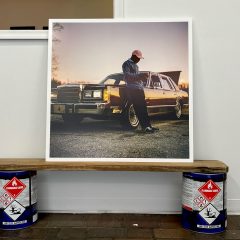What a relief to do an overnight in New York–it elevates the one-day marathon to a true vacation. This one included Renaissance portraits at the Met, Maurizio Cattelan at the Guggenheim, The Book of Mormon on Broadway and the Tenement Museum on the Lower East Side.
The Mormons and the Dubins
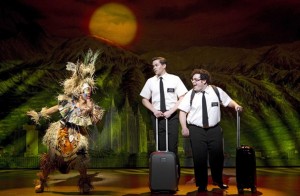
Back in April, my son Alex had a birthday, but we came up short on a gift. Alex loves musicals, so Murray tracked down tickets to the Book of Mormon for Alex, Lindsey and us. The wait has been long, but worth it. As musicals go, The Book of Mormon raises anti-PC humor to an astonishing level; it’s a musical that dares to suggest that belief in fucking a virgin to cure AIDS is no more outrageous than belief in the angel Moroni or in the virgin birth (yikes, two virgins, three religions, one sentence). Suited-up “Mormons” doing Busby Berkeley numbers are a highlight. So is relentless bad language delivered with exuberance. Can you snag a ticket to this? Eventually. Is it worth the wait? No doubt at all.
Cattelan and Renaissance Portraits
Sorry, Met, but we had a better time at the Maurizio Cattelan exhibit at the Guggenheim and at the tour at the Tenement Museum.
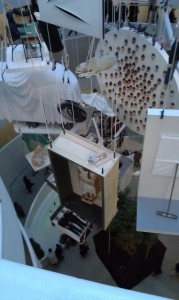
The impudent Cattelan’s 3-ring circus of an installation, All, is at once ebullient and melancholy. He hangs all his oeuvre, or close to it, in the atrium.
The experience has a Where’s Waldo quality, offering an opportunity to search and rummage through the artist’s past. Because the objects are often massive, are often mounted on floating plinths, and are numerous, they obscure one another, so the march up or down the ramp offers new perspectives and new revelations all along the way. The aerial act is both delightful and a constant revelation, filled with competing focal points–yes, a circus.
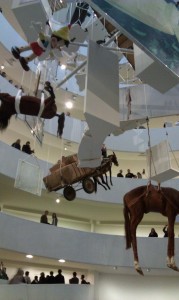
But as circus’ aerial acts get their power from the frisson of imminent danger, this installation gets some of its power from the frisson of imminent death. Cattelan has been a consistent explorer of the limits of the body and of happenstance and powerlessness. Even the Pope takes a licking and doesn’t keep on ticking in Cattelan’s world. John F. Kennedy, in his coffin, wears no shoes. A photo of hands reaching from the ground suggest a man buried in the sand still praying for succor to a God who doesn’t answer.
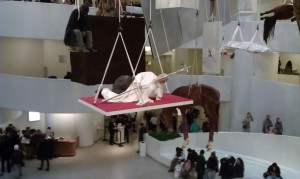
Taxidermied animals are stand-ins for humans. The powerful horse is reduced to a dead body. The tiny squirrel dies at the kitchen table. Cattelan ‘s use of Mme. Toussaud-like fleshtones parallels the taxidermied animals. The themes of death and powerlessness bring to mind the themes of another wax-works-style sculptor, Ron Mueck.
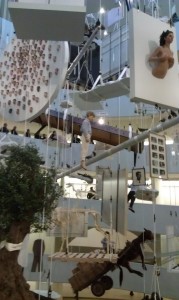
The exhibit is about the inevitability of failure and death. And speaking of final endings, the show ends Jan. 22.
The Renaissance Portrait From Donatello to Bellini, at the Met is marvelous, but the exhibition notes wore me down. I could barely take in what they were saying, and when I could, I found they raised more questions than they answered. For instance, on what basis do the curators assert that one man’s hair color is probably dyed. How do they know that?
The exhibit shows how portraiture began with strict, flat profiles and progressed to full-face and three-quarter face images. Equally wonderful and perversely obverse the continuity of portraiture. The 15th-century faces look contemporary and completely individual. They are the snapshots of their day–opportunities to commemorate events, relations and lovers, preserving them as keepsakes and aides memoires. Drawings, paintings and other works in this exhibit are astounding in their beauty and detail.
The show is huge–about 160 works (it must have cost a bundle to assemble). With such a wealth of material, it seems like an opportunity was lost in discussing more of the ethnographic, social and political issues suggested by the art–the 14-year-old brides (all blondes!); the arrival of dark hair with the Medicis. Oh, I know, it’s probably all in the catalog. In all truth, once I got done with the improvements in portraiture techniques, the social issues were what really interested me–that and all those beautiful portrayals of people who look so real they could be us.
The portrait show at the Met goes to March 18.
The Tenement Museum

Speaking of people who could be us, the other highlight of our trip was a visit to the Tenement Museum on the Lower East Side. We got to visit a 19th century structure, which over the course of its use housed about 7,000 people. We visited two apartments in the building, recreations that told the story of the people who lived there (during two separate eras). I was able to imagine myself in both eras and both kinds of lives, thanks to the wonderful presentation by our docent. Best of all, we got to see pictures of the descendants of those two families. Total feel-good melting pot American Dream experience!
And these days, the Lower East Side is chock-a-block with contemporary art galleries and little cafes. It has a West Philly vibe.



